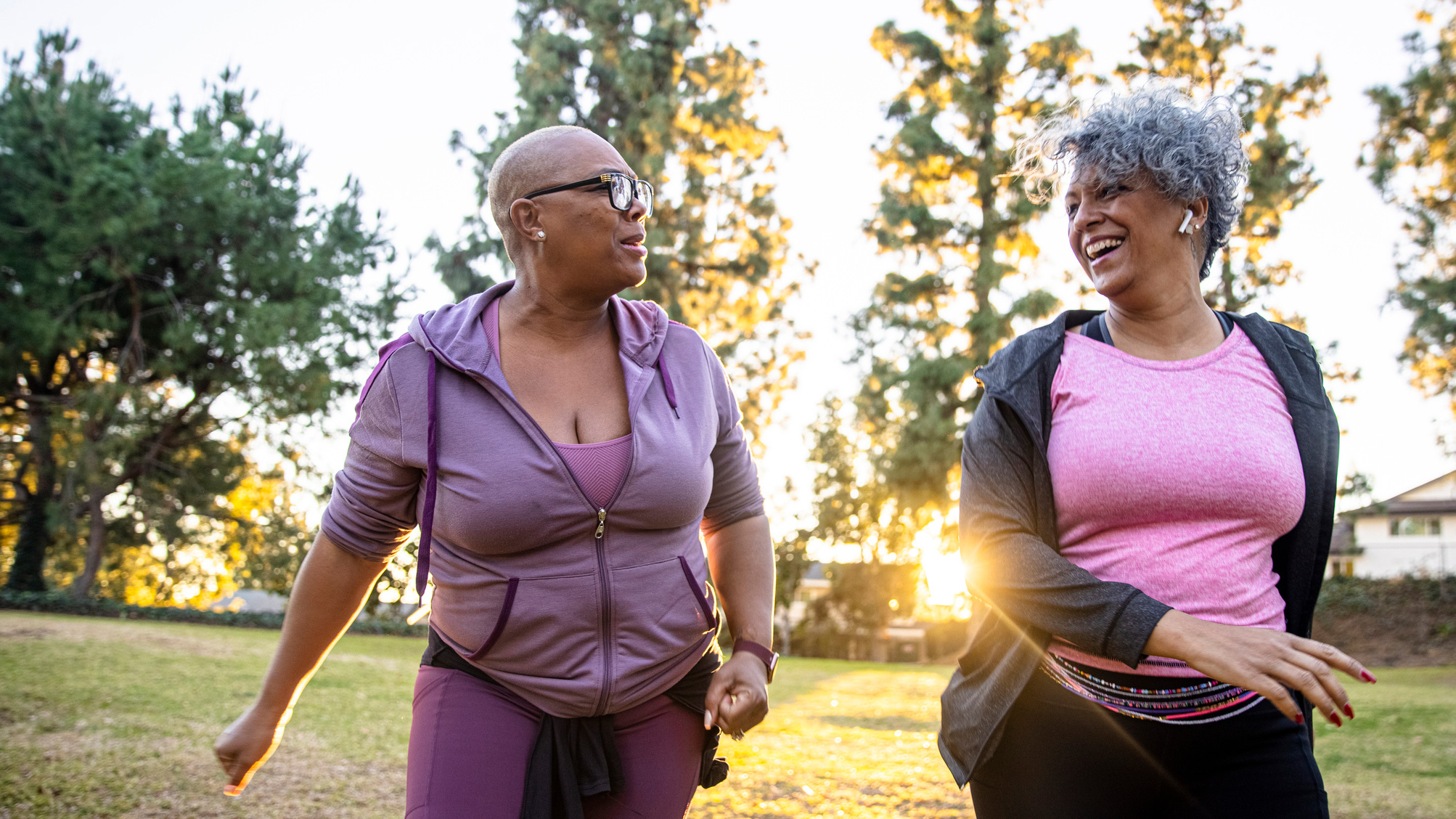Walking or running: Which one is more effective for weight loss?
Walking or running—We crunch the numbers and look at which exercise is best for losing weight (and right for you)


Walking or running? That’s a question a lot of people ask themselves, and there are benefits to both forms of exercise. Whether you’re coming to fitness for the first time, or dipping a toe back into the water after a long absence, or switching up your usual routine for some steady-state cardio, walking and running are two of the most popular choices because they can be done almost anywhere.
Lacing up a pair of the best running shoes for men, or best running shoes for women, and going out jogging has a plethora of benefits for the body and mind. Running can be as intense or as light, as you make it, while still being more strenuous than walking, so you work up a sweat and torch calories more effectively. However, the intense nature of running means regular road runners need special shoes to cushion their feet as they pound the ground to avoid injury and joint issues.
On the other hand, walking is lower intensity and a great way to begin your fitness journey. It can be done in almost any kind of training shoe to start off with (although for serious walks and optimal foot support, you may need a pair of the best shoes for walking). Almost anyone can go for a walk and add to their daily step count. This doesn’t have to be a dedicated hike: it could be a short walk around the block during a screen break or your lunch hour, or going to the grocery store by foot rather than your car. It’s a great way to stay active during everyday life.
This is the reason walking is often the first step on a beginner’s fitness journey, as some people are often intimidated by intense exercise and busy gym spaces. But the benefits of walking are plentiful, including improved heart health, a reduction in all-cause mortality, better circulation, and even better mental health.
However, if running is better at getting our heart rates up and provides those same benefits, are you wasting your time going for a stroll instead of a short run? If you were to start running instead, would you need to take health issues such as joint pain and cardiovascular problems into account? We look at the answers to all these questions and more, and examine the science behind whether you should be walking or running.

UK Athletics running coach and habitual ultra-runner Lily Canter is also a freelance health and lifestyle journalist who writes about fitness for Fit&Well, Runner's World and Trail Running magazines, to name just a few. Her ultra-running credits include 100 kilometers self-supported across the mountainous Snowdonia national park, and the 35 miles-long "Spires and Shires" ultra-marathon course.
Is walking or running better for weight loss?
Strictly speaking, looking at the science, running is a more efficient way to burn calories. One study published in the Journal of Strength and Conditioning Research found in average fitness individuals, running not only burned more calories than walking, but it also increased post-exercise energy expenditure, or how long you burn calories at an increased rate after the exercise is finished before your body returns to normal. You’re much more likely to get your breath back after a slow walk than you are a quick jog.
However, the difference in post-exercise expenditure was only five minutes, suggesting that both walking and running were perfectly valid forms of weight loss exercise.
Get the Fit&Well Newsletter
Start your week with achievable workout ideas, health tips and wellbeing advice in your inbox.
Studies like this also don't take into account the way we move every day. We walk the dog, walk to the shops, perhaps walk to work. Walking is an effective form of low-intensity exercise that's easy to incorporate into our daily lives. If you don't want to go for a run, walking more will end up being a better weight loss exercise for you because it's easy to incorporate into your day, and perhaps more enjoyable too.
Should I do walking or running?
Even though walking is not as intense as other forms of exercise, it’s still great for us: research from the University of Hong Kong found walking was “associated with better self-report and performance-based measures of physical function, better quality of life, and fewer depressive symptoms” in older adults. Older men and women might have weaker muscles, bones, and a more limited range of movement, which makes high-impact exercises unsuitable. However, this is exactly why walking is such an excellent form of exercise: its low intensity combined with its raft of benefits makes every step worth it.
Running is a terrific form of exercise because it’s more intense than walking, but not quite as demanding as really high-intensity forms of training like HIIT. If you are able to run short distances, taking regular breaks to start with, a 15-minute run is likely to burn more calories than a similar-length walk.
Don’t worry too much about joint health and bone density if you’re already healthy, providing you’ve got the right footwear. Running expert Lily Canter said: “Having a proper fitting at a running shop, even if you’re just starting out, that will make a difference in terms of avoiding injury. But if you start running on grass in your local park rather than on the sidewalk, that’s going to be a lot less impactful. Thinking about the surface that you’re running on is a good idea if you’re worried about the impact on your body.”
If you’re elderly, overweight, or really don’t enjoy running, go for a walk instead. If you’re interested in giving it a try, get some great shoes properly fitted and start slow, on a forgiving surface, taking regular breaks.

Walking or running: Low-impact vs high-impact exercise
Walking is considered to be a low-impact activity, like swimming or yoga. It shouldn’t cause any undue stress on a healthy person’s joints, certainly not compared to running: vigorous high-impact movement can cause joint stress if you’re overweight or have weak bones, according to Harvard University. It’s also low-intensity, which means it’s a great form of exercise for beginners to get you moving and your body used to physical exertion.
Running, as a high-impact exercise, is more intense, raising your heart rate and taxing your body more than a walk. Consequently, it might be too much for some beginners, overweight or older exercisers. However, if you can, running will offer you a ton of benefits, including burning an increased amount of calories compared to your average walk.
How to start running for weight loss
Canter recommends the walk-run technique if you're looking to transition from walking into a more intense jog.
“When you get started it’s just about taking it easy and gradually building it up. Try a gentle jog for two minutes, walk for five minutes and repeat that. Over time, you can adjust it so the walking element gets shorter and the running element gets longer. Break it down into a run-walk, you don’t have to go flat-out.”
The walk-run technique works on the same principle as other exercises: brief periods of exertion followed by "active recovery". It's what many beginner's running programs are based on. If you're just transitioning from walking to running, a walk-run program like Couch to 5k is a perfect place to start!
Matt Evans is an experienced health and fitness journalist and is currently Fitness and Wellbeing Editor at TechRadar, covering all things exercise and nutrition on Fit&Well's tech-focused sister site. Matt originally discovered exercise through martial arts: he holds a black belt in Karate and remains a keen runner, gym-goer, and infrequent yogi. His top fitness tip? Stretch.
-
 I do these two things every day to stay fit and healthy, says the newest star trainer on Chris Hemsworth's fitness app
I do these two things every day to stay fit and healthy, says the newest star trainer on Chris Hemsworth's fitness appHere's how Centr's Korey Rowe trains for longevity
By Sam Rider Published
-
 I thought sports weren't for me, until I realised they're a game-changer for ticking off cardio
I thought sports weren't for me, until I realised they're a game-changer for ticking off cardioI swapped HIIT and running for tennis—and I've never felt better
By Alice Porter Published